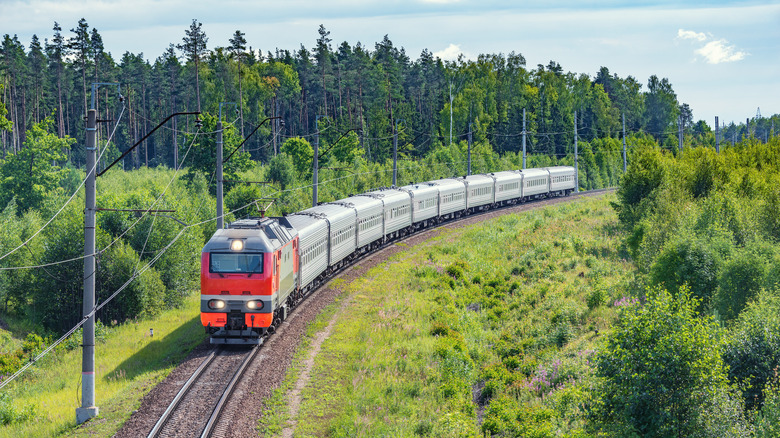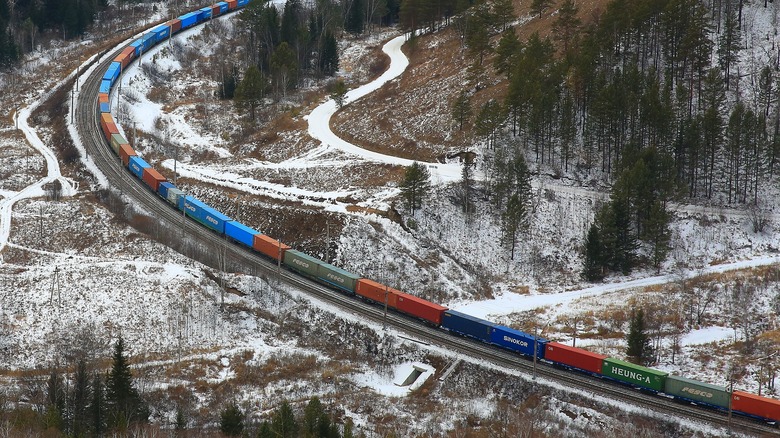
Serjio74/Getty Images
For centuries, citizens of the Eurasian continent have pondered an affordable and speedy way to traverse the great expanse of tundra separating Europeans from their Asian neighbors. And when the Soviet Union first completed the Trans-Siberian Railway in 1916, that dream took a great leap towards becoming a reality. In 2011, there were talks of extending the rail via tunnel to Alaska. Now, in the 2020s, things might soon take another leap forward.
Advertisement
Hints of the railway’s expansion to connect to Japan have generated a great deal of press attention and intrigue. In 2016, Japan expressed interest in connecting to the Trans-Siberian Railway, and in 2017, Russia proposed advancing the idea with plans to build a bridge between mainland Russia and the Russian island of Sakhalin. From there, the Trans-Siberian Railway could then theoretically link up with the Japanese rail networks via the short gulf to the Japanese island of Hokkaido. In fact, the two countries coordinated test shipments, and some work has been completed to increase the capacity of the railway in anticipation of such an expansion.
But based on the lull in press attention, progress appears to have stalled. For one, the war in Ukraine may have diverted resources and attention away from such plans, and it’s vague how much cohesion and cooperation is actually behind the proposal. Nonetheless, such a transcontinental enterprise is still achievable, political obstacles aside.
Advertisement
Extending the Siberian railroad to reach Tokyo would certainly require advanced engineering, but it’s possible and potentially economically feasible. How would a rail link that ostensibly connects London and Tokyo actually work? Let’s dive in to the details.
The trans-continental route: Not actually continuous

alleks19760526/Shutterstock
There have been several sensational headlines about a proposal that would link «London to Tokyo.» But these claims are misleading. For starters, the plan seems focused on trade routes, though such a rail link would also allow passenger travel. It mainly seeks to alleviate the expense of bringing Eastern goods to Europe via costly oceanic shipping routes. That’s probably why test runs involved sending Japanese goods to Moscow, a single load of products that required traversing oceanic waters.
Advertisement
Here’s where the train tracks stop and the sea crossing begins: The Russian island of Sakhalin is north of the Japanese island of Hokkaido. Sakhalin’s southernmost point is home to the Port of Vostochny, while Hokkaido’s northernmost point is home to the Port of Kobe. The two ports are separated by about 27 miles of ocean. Traversing the gulf is fairly easy for ships, but it nonetheless means that the proposed railway wouldn’t actually bridge the two countries. (Some sources mention a bridge between Sakhalin and Hokkaido, but there aren’t many details.)
While the gulf between Sakhalin and Hokkaido would likely need to be crossed by ship, a bridge between mainland Russia and Sakhalin is definitively on the table. One proposal from Russia seeks to do precisely that, with a 28-mile bridge connecting the mainland with the island. This would be the most significant step towards extending the railway’s international reach.
Advertisement
Thus, the link between Japan to the Trans-Siberian Railway won’t likely be a direct one. It would involve traversing the sea via ships to connect the two countries. Once Japanese cargo is delivered to this Russian port, it could then link up to the Trans-Siberian Railway. For international travelers, the same trans-oceanic exchange could apply.
The possibility of such Tokyo rail route: Politics meet logistics
A quick web search suggests that the hype surrounding a Trans-Siberian link to Japan has died off in the last few years. Recent reports are few and far between. With the war in Ukraine, it’s possible esources are getting diverted, and that includes train tracks and bridges. But whatever the reason may be, any such bridge has yet to be built.
Advertisement
However, the relationship between Japan and Russia is also a potential obstacle, one which may prove even more difficult to traverse than geography. The proposed crossing is in the middle of the Kuril Islands, the main point of contention that led to the failure of the two countries to sign a peace treaty after WWII. In fact, the Russo-Japanese war is one of the reasons Russia still uses armored military trains.
The proposal has been called a «bridge across history.» The plan was originally proposed by Russia, perhaps in an attempt to extend an olive branch to Japan. And from the Japanese side, most investments would be injected via private companies. The two logistic firms Toyo Trans and Hankyu Hanshin Express are behind the test shipments moving goods from Japan to Vladivostok (a Russian port connected to the Trans-Siberian railway). Connecting to Japanese rail lines would be a boost in speed, since Japan has one of the fastest rail lines in the world.
Advertisement
Thus, it appears that the logistics behind a Trans-Siberian link to Japan would involve private Japanese companies and governmental Russian public works incentives. Whether the historical dispute between both countries has been circumnavigated by the simple drive for businesses to find cheaper shipping routes remains to be seen.